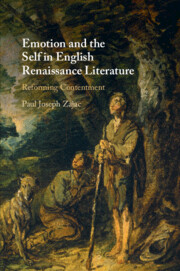Book contents
- Emotion and the Self in English Renaissance Literature
- Emotion and the Self in English Renaissance Literature
- Copyright page
- Dedication
- Contents
- Acknowledgments
- Introduction
- Chapter 1 Constructing Contentment in Reformation England
- Chapter 2 Romancing Contentment
- Chapter 3 Fashioning Contentment
- Chapter 4 Performing Contentment
- Chapter 5 Losing Contentment
- Conclusion
- Notes
- Bibliography
- Secondary Sources
- Index
Chapter 2 - Romancing Contentment
Sex, Suffering, and the Passions in Sidney’s Arcadias
Published online by Cambridge University Press: 15 December 2022
- Emotion and the Self in English Renaissance Literature
- Emotion and the Self in English Renaissance Literature
- Copyright page
- Dedication
- Contents
- Acknowledgments
- Introduction
- Chapter 1 Constructing Contentment in Reformation England
- Chapter 2 Romancing Contentment
- Chapter 3 Fashioning Contentment
- Chapter 4 Performing Contentment
- Chapter 5 Losing Contentment
- Conclusion
- Notes
- Bibliography
- Secondary Sources
- Index
Summary
Chapter 2 explores how Sidney uses literary form for passionate experimentation and develops a sophisticated affective vocabulary that intersects with the reformation of contentment. Neither The Old Arcadia nor the revised New Arcadia reproduce Protestant concepts of contentedness or proselytize an idealized Christian psychology. Instead, in The Old Arcadia Sidney pursues the strategies of romance, including the “wandering,” “error,” and “trial” described by Patricia Parker, and arrives at counter-intuitive and potentially scandalizing conclusions about the emotion. More specifically, Sidney aligns both sexual satisfaction and virtuous endurance with contentment, and he makes the character Pyrocles’s erotic fulfillment in Books 3 and 4 instrumental to his pious suffering in Book 5. However, in The New Arcadia, Sidney displaces the most extreme manifestations of desire from the four young lovers onto their antagonists, and he disentangles contentment and constancy in the face of adversity. By pushing contentment to the pastoral peripheries to emphasize the revised work’s more chivalric tenor, Sidney recoils from his most innovative contribution to the Renaissance discourse.
- Type
- Chapter
- Information
- Emotion and the Self in English Renaissance LiteratureReforming Contentment, pp. 50 - 75Publisher: Cambridge University PressPrint publication year: 2022

